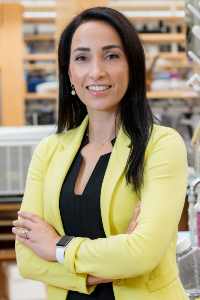Training an Immuno-Army to Fight Childhood Brain Cancer
This year’s BRIght Futures Prize finalists are pursuing forward-thinking and inventive research to improve patient care. Each of the three finalists hopes to receive the $100,000 BRIght Futures Prize, which will be awarded at Discover Brigham on Thursday, Nov. 7. Read about their work below, and vote for your choice.


Natalie Artzi, PhD
Bioengineer, Division of Engineering in Medicine
What problem are you trying to solve?
Brain tumors are the most lethal childhood cancer, with a median survival rate of only nine to 15 months — a measure that has not changed for 20 years. Despite extensive efforts to develop better therapies, there is currently no treatment that can cure brain cancer. Brain cancer cells are able to escape detection and destruction by the immune system. Since a highly selective membrane protects the brain, the blood-brain barrier (BBB), whose role is to prevent most molecules from penetrating into the brain, it makes it even more challenging for drugs to reach a brain tumor. This means that even higher — and more toxic — doses of a drug may not be very effective for patients with brain cancer.
What is your solution, and how would the BRIght Futures Prize allow you to pursue this?
Our solution is to deliver an adhesive patch that can reveal and kill cancer cells by (1) activating the immune system by using molecules that act as “danger” signals, and (2) delivering these molecules efficiently to the brain by using a material called an adhesive hydrogel, which can be sprayed onto and stick to the brain after surgery. This material allows us to locally release a cocktail of molecules that will activate the immune system while circumventing the BBB.
We plan to harness nanotechnology to form particles at a size of 1,000th the diameter of a single human hair. These nanoparticles specialize in penetrating cancer cells and may be programmed to deliver drugs at a predetermined rate. This technology will ensure that the immune system remains active and that the tumor will not come back.
The BRIght Futures Prize will allow us to take the first steps in making this therapy a reality. We will be able to make the hydrogels and test their safety and effectiveness in a preclinical model of brain cancer. This will allow us to attract the next round of funding to further perfect this technology before we reach patients.
How will your research project benefit people?
Based on our preliminary results, we are optimistic that our approach can increase the survival rate and minimize the side effects for children suffering from brain cancer. This would benefit individuals with brain cancer, their loved ones and their care teams. We would also like to provide the scientific community with a technology to treat other other solid tumors (for example, breast and lung cancer) and other diseases that can benefit from the local delivery of drugs.
Collaborators and Affiliations:
Robert Langer, ScD, Massachusetts Institute of Technology
Henry Brem, MD, Johns Hopkins University
CAST YOUR VOTE
or read more about the other BRIght Futures finalists:
 Home Test for Kidney Transplant Recipients Home Test for Kidney Transplant Recipients |


27 Responses to “Training an Immuno-Army to Fight Childhood Brain Cancer”
Amazing and so important!!!
I vote for it!
O boy for Itú.
Voto sim.
Parabéns por este trabalho e que Deus os abençoe
👍🏼
Promising!!! Best of luck!!!
Voto a favor!!!
I will vote for it
Like
Rebeca krimer
I will vote for it !!!
Maria Lúcia Araújo do Valle
Eu voto no Daniel / I vote for Daniel
Super importante!!!!
Congratulations
Parabéns!
Congratulations!
Voto em Daniel
Parabéns Daniel !
Deus vai escrever o certo com linhas retas
Eu voto em Daniel
Parabéns a equipe!
Eu voto em Daniel
Eu voto em Daniel
Meu voto é para Daniel❣️❣️
Meu voto no Leo Brasil
Eu voto em Daniel